
Heavy Metal magazine was my Playboy. It was the popular graphic distillation of the 1960’s underground comix movement, funneled through its French cousin, “Metal Hurlant” or “Howling Metal.” The American distributor, National Lampoon, provided a more above-ground slickness and accessability. Yes, the stories were filled with excessive breasts and blood, but they also had the most dynamic, influential artists of the era, from Bilal to Richard Corben to Moebius to Berni Wrightson. I first saw Charles Burn’s shadowed retro-pop grotesques in the pages of “Heavy Metal” with his wonderful should-be-a-movie, “El Borbah,” along with Drew Friedman’s devasting celebrity dissections. Each issue had great book, film and music columns, with one of the best interviews I’ve ever read with Stephen King on the cusp of over-exposure while Harlan Ellison ran pointed essays and openly critiqued the readers. I dug it all. The only two magazines I ever had a subscription for were “Fangoria” and “Heavy Metal.” To say it was an influence would be an understatement. I was drawing my own strange comix and the magazine was a major inspiration. Mr. Morris even confiscated a copy in my high school science class as possible pornography (he wishes). So I was thrilled when the magazine announced a animated film version.
 The chaotic, rushed production of HEAVY METAL: THE MOVIE is worthy of a whole book so I won’t even try. Suffice to say, Columbia Pictures wanted the film pushed ahead to summer instead of the projected Christmas release. This led to a mad scramble with animators around the world working on the same episodes under the direction of Gerald Potterton, who guided the YELLOW SUBMARINE to pop-art cartoon fame. The fast schedule doomed the film from being a truly groundbreaking animated work, but what was lost in cartoon glory was made up by other factors. What distinguishes HEAVY METAL from other comic adaptations is that it captures the spirit of the print version, not only in sex violence counterculture tone, but by featuring stories from the magazine, along with a terrific voice cast (made up of SCTV regulars due to producer Ivan Reitman’s influence) and one of the great eclectic rock soundtracks of all time. The fact that the film was animated and not done in live-action situates it on a whole other esthetic level from other comic book features — and staggeringly, this is the one thing that studios haven’t figured out.
The chaotic, rushed production of HEAVY METAL: THE MOVIE is worthy of a whole book so I won’t even try. Suffice to say, Columbia Pictures wanted the film pushed ahead to summer instead of the projected Christmas release. This led to a mad scramble with animators around the world working on the same episodes under the direction of Gerald Potterton, who guided the YELLOW SUBMARINE to pop-art cartoon fame. The fast schedule doomed the film from being a truly groundbreaking animated work, but what was lost in cartoon glory was made up by other factors. What distinguishes HEAVY METAL from other comic adaptations is that it captures the spirit of the print version, not only in sex violence counterculture tone, but by featuring stories from the magazine, along with a terrific voice cast (made up of SCTV regulars due to producer Ivan Reitman’s influence) and one of the great eclectic rock soundtracks of all time. The fact that the film was animated and not done in live-action situates it on a whole other esthetic level from other comic book features — and staggeringly, this is the one thing that studios haven’t figured out.
I saw HEAVY METAL opening night at the Birdcage Walk Theatre with a group of stoner friends (cue “Subdivisions”), the perfect screening at a time when people would light up the contraband during the movie itself. I loved the grinding metallic sound as the title appeared onscreen. I recall the audience bursting into laughter and applause during the naughty bits, and for many, this was the first time they’d seen cartoon characters swear, fuck and kill. Though Ralph Bakshi aspired to create adult animation, and on many levels he did, I always thought his Saturday Morning Style got in the way (but I dig WIZARDS of course). HEAVY METAL achieved that risque quality by just being itself, ripping the pages from the magazine. And like a comic, the only way to retro-view HEAVY METAL is to break it down, story by story.
 “Soft Landing” – The film starts with this clever bit of whimsy by Dan O’Bannon (ALIEN; TOTAL RECALL) featuring a space shuttle dropping a Porsche from its belly and the car’s journey to Earth. Soundtracked by The Rigg’s “Radar Rider,” the animation here is pure rotoscoping and can’t compete with Thomas Warkentin’s delicate original art, but the tunage and startling imagery kick-start the movie in high gear. The auto-naught (sic) turns out to be a scientist bringing home a canister holding the Loc-Nar, a glowing green ball that apparently is the source of all evil. Before the eyes of his young daughter, the Loc-Nar melts her father and orders the child to witness the dark history of the emerald orb. This loose narrative hook easily allows the stories to flow in and out with little trouble, albeit with little structure. Just like the magazine.
“Soft Landing” – The film starts with this clever bit of whimsy by Dan O’Bannon (ALIEN; TOTAL RECALL) featuring a space shuttle dropping a Porsche from its belly and the car’s journey to Earth. Soundtracked by The Rigg’s “Radar Rider,” the animation here is pure rotoscoping and can’t compete with Thomas Warkentin’s delicate original art, but the tunage and startling imagery kick-start the movie in high gear. The auto-naught (sic) turns out to be a scientist bringing home a canister holding the Loc-Nar, a glowing green ball that apparently is the source of all evil. Before the eyes of his young daughter, the Loc-Nar melts her father and orders the child to witness the dark history of the emerald orb. This loose narrative hook easily allows the stories to flow in and out with little trouble, albeit with little structure. Just like the magazine.
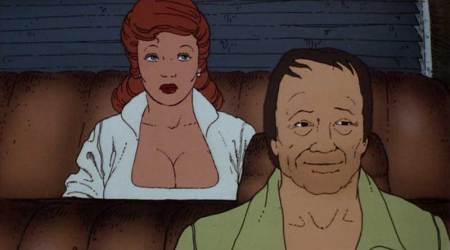 “Harry Canyon” – This segment alone is incredibly influential if only for the very BLADE RUNNER look of New York and for its sci-fi-noir underpinnings. Harry Canyon is your typical jaded cab-driver with attitude (perfectly voiced by Richard Romanus) who ends up trying to save a beautiful woman hiding the Loc-Nar from some evil gangsters. This section is also responsible for unleashing Journey’s “Open Arms” on an unsuspecting public. In terms of style, pith and pitch, “Harry Canyon” is probably the best cartoon in the movie, and might have worked as a whole feature. Well, for some it did since Luc Besson eventually adopted it for THE FIFTH ELEMENT…
“Harry Canyon” – This segment alone is incredibly influential if only for the very BLADE RUNNER look of New York and for its sci-fi-noir underpinnings. Harry Canyon is your typical jaded cab-driver with attitude (perfectly voiced by Richard Romanus) who ends up trying to save a beautiful woman hiding the Loc-Nar from some evil gangsters. This section is also responsible for unleashing Journey’s “Open Arms” on an unsuspecting public. In terms of style, pith and pitch, “Harry Canyon” is probably the best cartoon in the movie, and might have worked as a whole feature. Well, for some it did since Luc Besson eventually adopted it for THE FIFTH ELEMENT…
“Den” – You can’t write the history of “Heavy Metal” without including Richard Corben, who came from the underground world to become the publication’s most popular and representative artist (even painting the film’s poster). His archetypal story, “Neverwhere,” about a science nerd who finds himself in an alternate world with new endowments, sums up the best and worst of the magazine, depending on your bent. Corben’s art is cinematic, depthful and dynamic and he even made a “Neverwhere” short in 1968 which is of course far superior to this version. Despite the lackluster animation, probably the worst in the movie, there’s a lot of fun to be had in this ultimate geek fantasia. John Candy is great as Den (Corben thought so too) and his glee at becoming a bad-ass warrior is contagious. At least the animators tried to reflect Corben’s style and storyboards. Elmer Bernstein contributes a magnificent score that pumps up the epic adventure volume and deserves a major remastered release. Whatever one thinks of “Den,” it pulls the audience right into the outrageous adolescent world of the magazine.
“Captain Sternn” – Another direct upload from the magazine (and one of my favorites) is this Berni Wrightson MAD Magazine-style shaggy-dog story that doesn’t quite work as well in the film, losing Wrightson’s intricate panel gags and replacing the end with a darker take. But you do get Joe Flaherty, Eugene Levy, John Vernon AND a great Cheap Trick song. What more could you want from a dirty cartoon on a Friday night in suburbia?
 “B-17” – A Dan O’Bannon-penned story about a bomber plane taken over by the Loc-Nar and re-animating the dead pilots that mimics the E.C. fright comics of the 1950’s. Featuring supercool Mike Ploog designs and incredible gore as befits its pulp horror origins, “B-17” is the perfect transitional segment between the lighter ones and fits in with the disparate nature of the magazine. Although some don’t like Don Felder’s “Heavy Metal (Takin’ A Ride)” song that opens a World War II zombie tale (Bernstein’s opening score was replaced to make more room for the double LP rock) I find it somehow works against my better nature.
“B-17” – A Dan O’Bannon-penned story about a bomber plane taken over by the Loc-Nar and re-animating the dead pilots that mimics the E.C. fright comics of the 1950’s. Featuring supercool Mike Ploog designs and incredible gore as befits its pulp horror origins, “B-17” is the perfect transitional segment between the lighter ones and fits in with the disparate nature of the magazine. Although some don’t like Don Felder’s “Heavy Metal (Takin’ A Ride)” song that opens a World War II zombie tale (Bernstein’s opening score was replaced to make more room for the double LP rock) I find it somehow works against my better nature.
 “So Beautiful & So Dangerous” – The one series taken from the magazine that loses almost everything in translation is Angus McKie’s Douglas Adams-esque story about a cadre of aliens who take a group of humans on a trip through the galaxy. Reduced to a sex and drug skit, the segment nevertheless features some of the best art and animation in the film, perfectly duplicating McKie’s spectacular painted vistas. It also acts as HEAVY METAL’s stoner interlude (look for the splintered Enterprise) with fun voice-work from Candy and Harold Ramis. And Sammy Hagar’s rendition of the title is rawkin’.
“So Beautiful & So Dangerous” – The one series taken from the magazine that loses almost everything in translation is Angus McKie’s Douglas Adams-esque story about a cadre of aliens who take a group of humans on a trip through the galaxy. Reduced to a sex and drug skit, the segment nevertheless features some of the best art and animation in the film, perfectly duplicating McKie’s spectacular painted vistas. It also acts as HEAVY METAL’s stoner interlude (look for the splintered Enterprise) with fun voice-work from Candy and Harold Ramis. And Sammy Hagar’s rendition of the title is rawkin’.
“Taarna” – The Loc-Nar’s story is almost done as we come to the last, and for many, best, segment. It’s the longest, most epic story in the movie. Originally intended to be Moebius’s “Arzach,” this was retro-fitted with the evil green orb rendering a future populace into evil green barbarians and the only savior being one “Taarna,” a female warrior from the mythic Tarakian race. It’s of course interesting that in a film of male fantasies that the hero of this final tale is a powerful woman — who is naked about 30 percent of her rotoscoped screen time. Yet she kicks male booty left and right, and you’re on her side all the way through, whether it’s luxuriously putting on her battle gear (a lovely fetishistic moment), tenderly caring for her brave bird wingman or lopping the heads off barroom thugs.
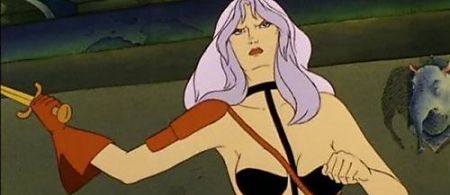 There’s much fantastic graphics and animation on display, particularly Taarna flying her bird through a lush multi-plane landscape. Bernstein’s music is apropos heroic, majestic, becoming itself part of the action. The showdown between Taarna and the Barbarian Leader is exciting and kinetic; it’s utterly satisfying when she flips off the dying leader’s helmet and punches him in the face. This leads to her destroying the giant glowing ball o’ Loc-Nar and we find that the little girl is in fact Tarnna and the circle is complete. Throw in Devo AND Black Sabbath songs and you have a sort of mini-animated classic. As you can tell, I love “Taarna” and think it a perfect ending to what could have been a disastrous film.
There’s much fantastic graphics and animation on display, particularly Taarna flying her bird through a lush multi-plane landscape. Bernstein’s music is apropos heroic, majestic, becoming itself part of the action. The showdown between Taarna and the Barbarian Leader is exciting and kinetic; it’s utterly satisfying when she flips off the dying leader’s helmet and punches him in the face. This leads to her destroying the giant glowing ball o’ Loc-Nar and we find that the little girl is in fact Tarnna and the circle is complete. Throw in Devo AND Black Sabbath songs and you have a sort of mini-animated classic. As you can tell, I love “Taarna” and think it a perfect ending to what could have been a disastrous film.
I saw HEAVY METAL many more times in the years to come, primarily at smoky midnight shows where it remained a staple next to THE WALL, DAWN OF THE DEAD and THE SONG REMAINS THE SAME. Thanks to music rights, it took decades before it was made available on home video, in a dazzling DVD with lots of great extras, such as alternate scenes and the rough print of “Neverwhere Land” by animator Cornelius Cole. Dropped due to time constraints, it’s almost too good for the film, the style and intent is so startlingly different. A five-minute journey through the history of evil with the Loc-Nar as instigator, inked completely with colored ball-point pen, “Neverwhere Land” would have pulled the howling metal movie into FANTASIA territory. Maybe it was just too artful.
As it stands now, HEAVY METAL represents the remnants of the underground comix counterculture merging into the mainstream. The movie was a hit, benefitting from the 80’s sword-n-fantasy wave that started with EXCALIBUR and even spawned a best-selling double soundtrack, one of the decade’s best. The less said about the 2000 sequel the better, though it’s a testament to the feature’s iconic power that a new production is to be helmed by David Fincher and James Cameron.
Despite the wonky, inconsistent animation, HEAVY METAL remains true to its wild subversive print source, reminding me of those long ago nights drawing and rawking to a new issue of The Adult Illustrated Fantasy Magazine…”It’s your one way ticket to midnight/Call it…”
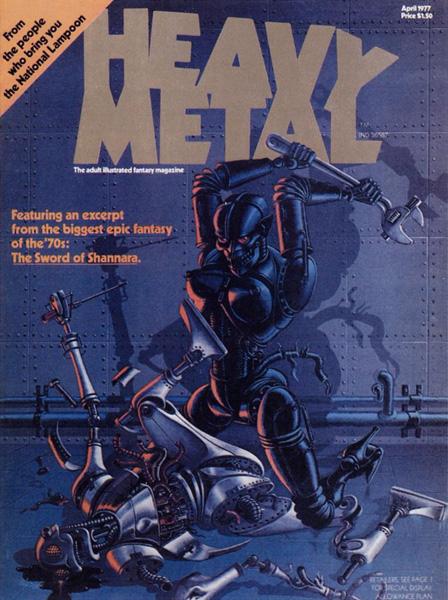
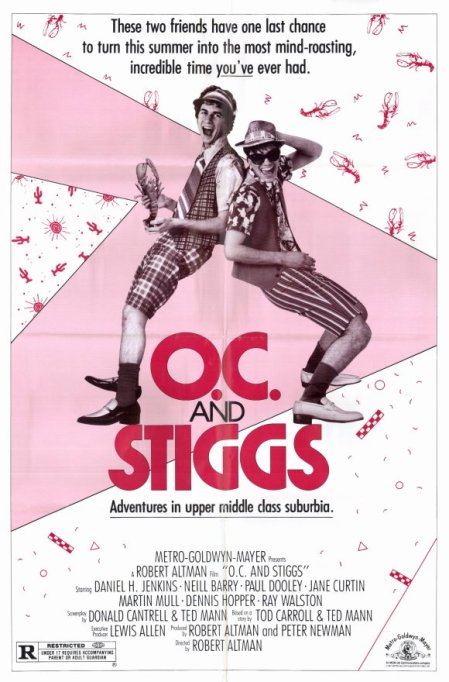 “And so, because Lenora was so artistic and withdrawn and delicate, and totally unable to function anyplace where there were any people or any windows or anything else that might suck her into a connection with the world, me and Stiggs got her an Uzi submachine gun for a wedding present, with a twenty-round clip and a detachable stock.”
“And so, because Lenora was so artistic and withdrawn and delicate, and totally unable to function anyplace where there were any people or any windows or anything else that might suck her into a connection with the world, me and Stiggs got her an Uzi submachine gun for a wedding present, with a twenty-round clip and a detachable stock.” 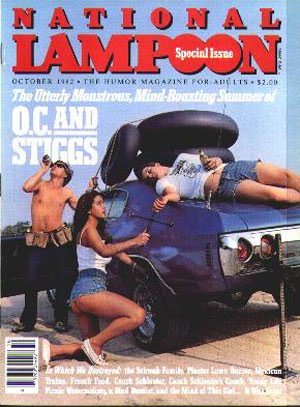 Actually, the film should be titled NATIONAL LAMPOON’S O.C. AND STIGGS as it stems from the only issue-length story that appeared in the amoral, hilarious and influential humor magazine. “The Utterly Monstrous Mind-Roasting Summer of O.C. and Stiggs” as written by Ted Mann and Donald Cantrell was a mosaic of clips, images and first-person narrative deal about the sociopathic adventures of two teen monsters, O.C. and Stiggs, who terrorize the wealthy Schwab family for no particular reason as they lay waste — and waste lays — among the slut populace. Written in the dry, cruel style so indigenous to the magazine, one can read the sordid tale as a piercing satire of suburban anomie, or as another variation of ANIMAL HOUSE. One can also only imagine why Altman decided to take on this incongruous project during the wilderness phase of his career, but he must have hoped to parody the genre and puncture other sacred cows of the ’80’s. In the story, the abuse of the Schwabs was apolitical; in the film, they represent the fundamentalist right.
Actually, the film should be titled NATIONAL LAMPOON’S O.C. AND STIGGS as it stems from the only issue-length story that appeared in the amoral, hilarious and influential humor magazine. “The Utterly Monstrous Mind-Roasting Summer of O.C. and Stiggs” as written by Ted Mann and Donald Cantrell was a mosaic of clips, images and first-person narrative deal about the sociopathic adventures of two teen monsters, O.C. and Stiggs, who terrorize the wealthy Schwab family for no particular reason as they lay waste — and waste lays — among the slut populace. Written in the dry, cruel style so indigenous to the magazine, one can read the sordid tale as a piercing satire of suburban anomie, or as another variation of ANIMAL HOUSE. One can also only imagine why Altman decided to take on this incongruous project during the wilderness phase of his career, but he must have hoped to parody the genre and puncture other sacred cows of the ’80’s. In the story, the abuse of the Schwabs was apolitical; in the film, they represent the fundamentalist right. As for the plot, well, that’s not important but it involves lobsters, Vietnam vets and a Studebaker christened, The Gila Monster. The dialogue is archetypal Altman, weaving in the background and foreground, forcing the viewer to listen or to follow the voices. One can see how alienating this would be to the potential audience of Valley Girls and Boys to whom the film was ostensibly marketed. But isn’t that exactly what the director wanted? O.C. AND STIGGS is like buying the new O.M.D. record in 1987 and finding out it’s King Sunny Ade, the juju musician who provides the jaunty songs and appear in a penultimate scene. Reportedly the movie was shot in a rush so MGM wouldn’t interfere and it shows — there’s a disjointedness that can be perceived as intentional if not completely successful. You can zone in and out of the film while you’re watching; I don’t even know what the hell to make of O.C. AND STIGGS.
As for the plot, well, that’s not important but it involves lobsters, Vietnam vets and a Studebaker christened, The Gila Monster. The dialogue is archetypal Altman, weaving in the background and foreground, forcing the viewer to listen or to follow the voices. One can see how alienating this would be to the potential audience of Valley Girls and Boys to whom the film was ostensibly marketed. But isn’t that exactly what the director wanted? O.C. AND STIGGS is like buying the new O.M.D. record in 1987 and finding out it’s King Sunny Ade, the juju musician who provides the jaunty songs and appear in a penultimate scene. Reportedly the movie was shot in a rush so MGM wouldn’t interfere and it shows — there’s a disjointedness that can be perceived as intentional if not completely successful. You can zone in and out of the film while you’re watching; I don’t even know what the hell to make of O.C. AND STIGGS.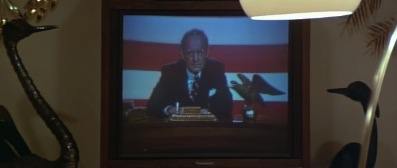







 The chaotic, rushed production of HEAVY METAL: THE MOVIE is worthy of a whole book so I won’t even try. Suffice to say, Columbia Pictures wanted the film pushed ahead to summer instead of the projected Christmas release. This led to a mad scramble with animators around the world working on the same episodes under the direction of Gerald Potterton, who guided the YELLOW SUBMARINE to pop-art cartoon fame. The fast schedule doomed the film from being a truly groundbreaking animated work, but what was lost in cartoon glory was made up by other factors. What distinguishes HEAVY METAL from other comic adaptations is that it captures the spirit of the print version, not only in sex violence counterculture tone, but by featuring stories from the magazine, along with a terrific voice cast (made up of SCTV regulars due to producer Ivan Reitman’s influence) and one of the great eclectic rock soundtracks of all time. The fact that the film was animated and not done in live-action situates it on a whole other esthetic level from other comic book features — and staggeringly, this is the one thing that studios haven’t figured out.
The chaotic, rushed production of HEAVY METAL: THE MOVIE is worthy of a whole book so I won’t even try. Suffice to say, Columbia Pictures wanted the film pushed ahead to summer instead of the projected Christmas release. This led to a mad scramble with animators around the world working on the same episodes under the direction of Gerald Potterton, who guided the YELLOW SUBMARINE to pop-art cartoon fame. The fast schedule doomed the film from being a truly groundbreaking animated work, but what was lost in cartoon glory was made up by other factors. What distinguishes HEAVY METAL from other comic adaptations is that it captures the spirit of the print version, not only in sex violence counterculture tone, but by featuring stories from the magazine, along with a terrific voice cast (made up of SCTV regulars due to producer Ivan Reitman’s influence) and one of the great eclectic rock soundtracks of all time. The fact that the film was animated and not done in live-action situates it on a whole other esthetic level from other comic book features — and staggeringly, this is the one thing that studios haven’t figured out.



 There’s much fantastic graphics and animation on display, particularly Taarna flying her bird through a lush multi-plane landscape. Bernstein’s music is apropos heroic, majestic, becoming itself part of the action. The showdown between Taarna and the Barbarian Leader is exciting and kinetic; it’s utterly satisfying when she flips off the dying leader’s helmet and punches him in the face. This leads to her destroying the giant glowing ball o’ Loc-Nar and we find that the little girl is in fact Tarnna and the circle is complete. Throw in Devo AND Black Sabbath songs and you have a sort of mini-animated classic. As you can tell, I love “Taarna” and think it a perfect ending to what could have been a disastrous film.
There’s much fantastic graphics and animation on display, particularly Taarna flying her bird through a lush multi-plane landscape. Bernstein’s music is apropos heroic, majestic, becoming itself part of the action. The showdown between Taarna and the Barbarian Leader is exciting and kinetic; it’s utterly satisfying when she flips off the dying leader’s helmet and punches him in the face. This leads to her destroying the giant glowing ball o’ Loc-Nar and we find that the little girl is in fact Tarnna and the circle is complete. Throw in Devo AND Black Sabbath songs and you have a sort of mini-animated classic. As you can tell, I love “Taarna” and think it a perfect ending to what could have been a disastrous film.
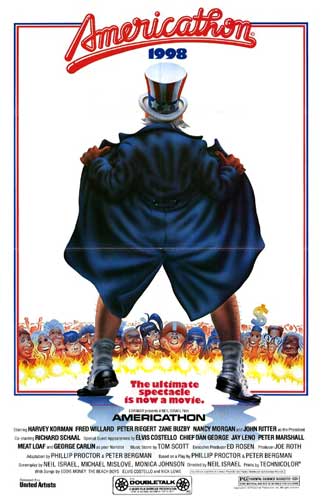 One of the many raunchy counterculture comedies of the later 1970’s, AMERICATHON shared a slapdash, tasteless, revue style with films like
One of the many raunchy counterculture comedies of the later 1970’s, AMERICATHON shared a slapdash, tasteless, revue style with films like  Throw in narration by George Carlin; ANIMAL HOUSE co-star Peter Reigert; Fred Willard; Howard Hesseman; Jay Leno; Chief Dan George (John Carradine’s cameo as a drunken Uncle Sam was unwisely cut) along with the obligatory eclectic music cameos by Meatloaf (who fights a car), The Beach Boys and Elvis Costello (!) and you have an odd exploitation movie that played on late night HBO a dozen times (where I first saw it). Written and directed by Neal Israel (who also did TUNNELVISION), based on a play by Firesign Theater genius Phil Proctor, AMERICATHON has just enough humorous ideas to be watchable, even when it’s not all that funny. The opening scene of 1998 Los Angeles with Reigert waking up in his car home along with hundreds of others has stuck with me since my first and only viewing way back when. The rest of the film, not so much. But it is fascinating as a slice of surreal comedy cinema. And obviously has some resonance today.
Throw in narration by George Carlin; ANIMAL HOUSE co-star Peter Reigert; Fred Willard; Howard Hesseman; Jay Leno; Chief Dan George (John Carradine’s cameo as a drunken Uncle Sam was unwisely cut) along with the obligatory eclectic music cameos by Meatloaf (who fights a car), The Beach Boys and Elvis Costello (!) and you have an odd exploitation movie that played on late night HBO a dozen times (where I first saw it). Written and directed by Neal Israel (who also did TUNNELVISION), based on a play by Firesign Theater genius Phil Proctor, AMERICATHON has just enough humorous ideas to be watchable, even when it’s not all that funny. The opening scene of 1998 Los Angeles with Reigert waking up in his car home along with hundreds of others has stuck with me since my first and only viewing way back when. The rest of the film, not so much. But it is fascinating as a slice of surreal comedy cinema. And obviously has some resonance today.